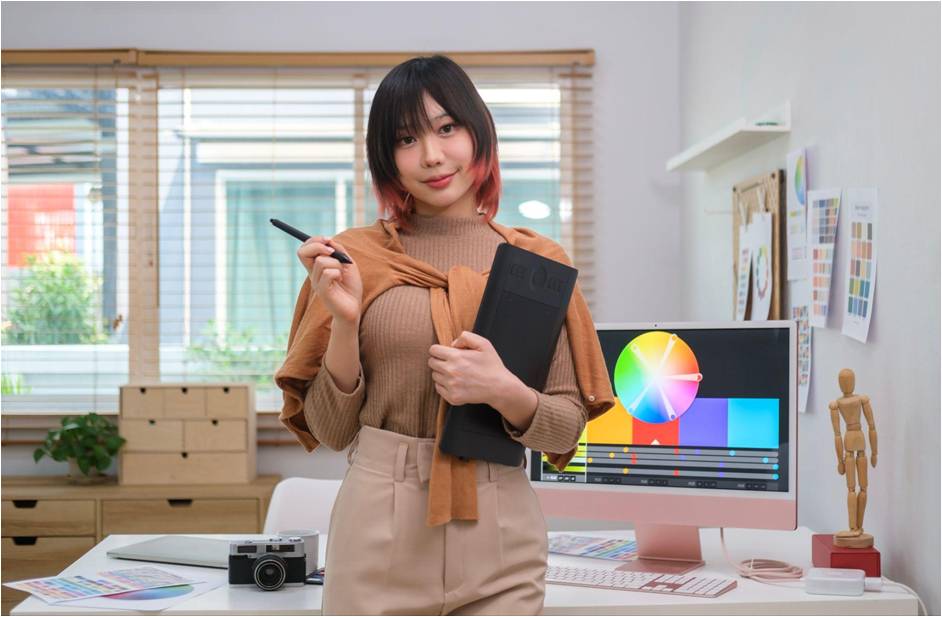For those who love creativity, graphic design can be a rewarding career choice—as it brings your imagination, skill, and a good work ethic to the table.

Graphic design has always been a brilliant choice for those who love art and creativity. However, in this landscape, both students and professionals now have more access to technology and training than ever before, making it all the more exciting. But with more tools you get more competition too. To become a skilled designer, gaining a competitive edge becomes crucial for a successful graphic design career.
How to Develop Graphic Design Skills
So we have created a starting point for your initial foray into digital editing and elevating your work to a global audience in today’s competitive marketplace.
Start Dabbling With Industry Tools
Although most graphic designers do eventually go on to get themselves a tertiary education (more on that below), it’s common for passionate people to get a head start on building their skills by tinkering with industry technologies like design software.
So the best idea is to get to know some of the software you’re likely to work on when producing work for paying clients. This includes paid subscription software like Adobe’s Creative Suite, but more importantly, you’ll be surprised to know how important it is to know free tools like Adobe Express and Sketch too.
These free-to-use tools – especially those like Adobe Express that can help you develop a foundational understanding of Adobe’s other nifty software offerings. Plus with many more features like animations, free assets and video creation tools, it’s even becoming popular in work environments nowadays. Be sure to spend time exploring all of the tools available to you, familiarising yourself with their features to effectively expand on your own output capabilities.
Start Your Education Journey
Once again, whilst it’s not technically necessary to secure a tertiary qualification in graphic design to work on a freelance basis, earning your degree definitely helps build your legitimacy (and even your professional network).
And for those who are looking to work as an in-house designer for large design firms or even for corporations, a bachelor’s degree or even a tailored diploma in graphic design is usually needed to work as a professional graphic designer anywhere in the world. Enrolling in a dedicated graphic design course provides structured learning, offering a comprehensive understanding of design theory and practical applications. It can also help you connect with like-minded young designers and even course coordinators who may be able to provide you with leads on graphic design jobs once you graduate.
Practice, Practice, Practice
They say that practice makes perfect. It’s actually perfect practice that makes perfect. In the formative years of your study, it is essential to finetune all of your skills without developing poor habits that will stick with you for life.
This is also a time where you should experiment. It can become easy to be locked into certain styles that you love, have been influenced by or styles that you have demonstrated a natural knack at excelling at. However, in the real world, you are going to be expected to be an all-rounder.
Learn about the latest trends in colors, fonts, web design, marketing, and more. Learn about platforms that offer creative tools like fonts and vectors, learn to make your own, or customize them. Also dabble with animations, poster-design, logo design or anything else you love.
Practice different styles, especially the ones you are weakest at. Go deep into the software platforms you are using and learn how to use all of the tools, not just your favorites. The more elements of design you can perfect, the better your employment chances will be.
Here is a great tip: Over 50 percent of all graphic designers work in the advertising and public relations industry, while others leading industries include publishing, web design, and packaging design. Be sure to refine your skills to impress in these fields.
Stay on Top of Changes in the Design Industry
The world of graphic design is always evolving. New trends emerge, old ones fade. Stay updated with the latest developments in the field. Read blogs, follow influential designers, join design communities, and attend workshops and seminars.
A major trend today is the use of artificial intelligence and many young digital artists and graphic designers want to know if they should leverage this technology.
AI is expected to see an annual growth rate of 37.3 percent from 2023 to 2030 and graphic design is one of the fields that will be most impacted by the development of artificial intelligence platforms.
The good news is that AI generators are not going to take the jobs of real graphic designers in the real world. While these tools can be used to increased efficiency and create time and cost savings, Generative AI tools like Stable Diffusion, DALL-E 2, Midjourney, Adobe Firefly will never be able to emulate the originality, emotional intelligence, ethics or problem-solving skills that real humans possess.
How to Showcase Your Graphic Design Skills
Now that we’ve walked through the steps to develop your graphic design skills, let’s discuss how to showcase them to the world.
First impressions matter in all walks of life and you will often only have a limited window to impress in the field of graphic design. All those years of learning, all those long hours and all that creative flair come down to a single, curated collection of your work – your portfolio.
Failing to capture your skills and creativity in your portfolio will terminate your career before it even gets off the ground, so it is vital to get this right. Here are some tips to create a compelling portfolio:
1. Prioritize Quality Over Quantity
It can be easy to try and cram your portfolio full of your best work over a broad range of industries, but most employers are only going to spend a limited amount of time looking at your work and will not be impressed by a portfolio that is bloated and disorganised. Only include the very best examples of your work that show your creative flair, technical prowess and where you have overcome design challenges. Prioritise content that has been published and already received well by a wide audience.
2. Display a Variety of Work
While having a niche is valuable, don’t shy away from revealing your versatility. Incorporate a diverse array of projects in your portfolio, spanning logos, websites, brochures, or packaging designs. This diversity will underscore the breadth of your skills to potential clients or employers.
3. Weave a Good Narrative
Infuse storytelling into each piece of your portfolio by including every step of the journey, from the original client brief to the final content, highlighting the challenges you have experienced along the way and how you have navigated and conquered those challenges. This narrative provides prospective employers with a deeper understanding of your design process and problem-solving prowess.
4. Stay Relevant
Keep your portfolio in sync with your ambition. As you enhance your skills, undertake new projects, or shift your focus, update your portfolio to reflect these positive changes. An up-to-date portfolio signals growth and dynamism, while an outdated one may inadvertently convey a sense of stagnation.
While choosing to become a graphic designer in a modern world full of competition and disruptors like artificial intelligence may initially appear daunting, there is more demand than ever for leading designers across a wide range of creative industries.
5. Go for an Internship
Many large companies as well as small firms and startups offer summer internships, and even year-long programs. The best way to choose the right one is to look at companies whose work inspires you, and you feel like being a part of their team. Internships are the best way to learn industry standards, best practices, teamwork and new trends. They’re also a great way to improve your design skills, be more creative and perfect your digital skills.
By combining hard work with a strong working knowledge of leading design platforms and your own creative juices, a rich career in design awaits. Remember, every great designer started somewhere, and with dedication and passion, you too can create designs that communicate, captivate, and inspire.

Anika Sachdev is a freelance writer, who writes about upcoming careers and academic studies. She is currently pursuing her diploma in Fashion Design from iNIFD. She enjoys writing, making illustrations and tracks AI technologies. Based in Mumbai, she likes to draw and listen to Bollywood music in her free time. For any questions, feedback or concerns, please email [email protected].